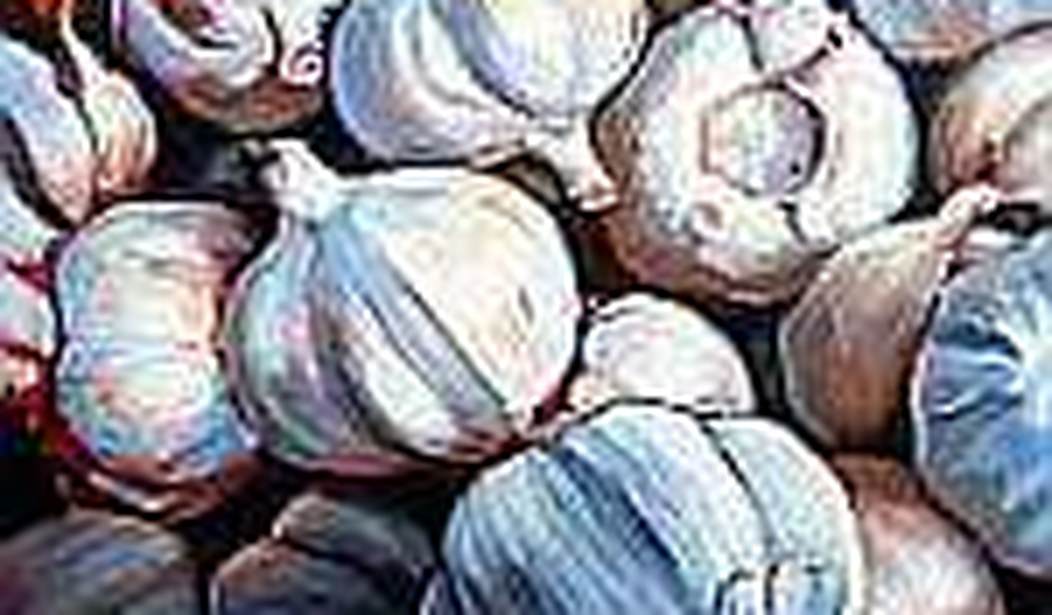Every Saturday morning, my husband and I work a farmers market. For five hours, I stand within our booth being charming and informative (qualities that, about 40 minutes before closing, flee entirely) while he hustles fresh coffee back and forth from the shop. Though I am surrounded by dozens of farmers and their wares, I don’t really get to walk around and sample, and so observe the changing of the seasons, from rutabagas to asparagus to strawberries to gourds, from within my little tent.
Which turns out to be okay, because first thing in the morning, before the market opens, the vendors come to me, for coffee. Instead of money, we barter. Which means I have been the recipient of jars of honey, pounds of morels, bouquets of peonies as big as babies’ heads, and sugar-sweet carrots the size of my pinkie. The past two weeks, however, I have for the most part been given one item and one item only, and that is garlic, garlic in its many forms, garlic green and red and white; garlic long and curled, and in heads as big as my fist. And I have dutifully eaten my way through all this garlic, and can report, because of the products’ freshness, I still have people willing to talk to me. This is because fresh garlic is sweet, rather than pungent. And while I cannot say I have been overly adventurous in my treatment of the garlic, using each in an uncooked or barely-cooked sauce for pasta, I have come away with some opinions, in time for garlic season.
First, a little garlic primer: Garlic is part of the allium, or onion family. We can trace its origins back 5,000 years, to Middle Asia; it was a favorite in ancient Greece, and is thought to have made its was to America via Europe, though perhaps earlier: according to Food by Waverly Root, “[when] an unruly member of the Cortez foray into Mexico… [was] put into stocks freshly made to order by the natives, he complained that the wood smelled of garlic-communicated to it, one would suppose, by well-fed carpenters.”
Today, Americans eat 250 million pounds of garlic annually. Until recently, the majority of garlic consumed was grown in this country, though that ranking has been outstripped by China, a cause of some contention, especially amongst garlic growers in Gilroy, California, which bills itself as the nation’s garlic capital and which this July will hosts its annual garlic festival. As far as garlic’s reputation as “the stinking rose,” garlic actually has very little odor-until you cut it, and a compound called allicin is released. As for that cutting: to get the clove from its skin, lay it on a cutting board, smash it with the broad side of a knife, and the paper sheath will come right off. You can then use the garlic smashed, or submit it to further chopping. A garlic press, however, is considered an extraneous no-no: clunky and smelly and just one of many unnecessary garlic gadgets.
Okay, onto the garlic I have received. The first was head of fresh garlic with a rose-colored skin. “It’s mild,” said the vendor. “You can practically eat it raw.” The cloves themselves were soft and moist, and the flavor, sweet and mild; I saut√©ed up two entire heads with a little olive oil and fresh basil, mixed that with a pound of pasta, and felt none of garlic’s signature burn.
The next was a bunch of garlic scapes, or what I came to think of as uncircumcised garlic, for their hooded bulbous heads. The bodies look a good deal like longer, stiffer scallions, though they curl at the ends. I was told by this farmer to “eat the whole thing,” and did, rough-chopping the scapes, fresh tomatoes and basil, which I sizzled in a pan, with some hot butter. But I can’t say I liked them too well; they were a bit woody, with a faintly musky flavor, or perhaps it is just not a flavor I like.
Last week, I was given something very special, a head of what the farmer called red garlic, a big dense bulb whose thick skin was actually a furious lilac.
“Eat it soon, and it will be mild,” said the farmer. “It gets sharper as it gets older.”
Don’t we all.
Once home, I broke open the head, then a clove: it smelled both sweet and strong, and I decided, the best way to use it was in a simple pesto, the recipe for which is below.
As for garlic’s ancillary effects, to rid your hands of the smell, rub your fingers with lemon juice and/or salt. To sweeten the breath, chew something rich in chlorophyll, such as parsley or cilantro, which neutralizes the odor, and follow with a drink of an acidic liquid, wine being the perfect complement and foil.
Genovese Pesto
2 cups fresh basil leaves, washed
1 – 2 cloves fresh garlic
¼ cup pine nuts
2 tablespoons freshly grated Parmesan cheese
1 cup good fruity olive oil
Place all ingredients in food processor. Blend until just smooth; you want a little texture. Makes about 1 ¬Ω cups, more than enough for a pound of pasta.









Join the conversation as a VIP Member